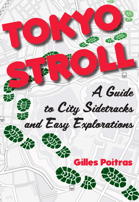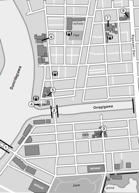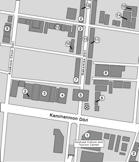











Tokyo Stroll Supplement: Mitaka

This page is for locations in the Mitaka area of Tokyo. This neighborhood is not part of my book Tokyo Stroll.
For information on Tokyo Stroll and this web supplement see Tokyo Stroll Supplement home page
For users of the Organic Maps, Maps.Me and Google Maps apps the items below have bookmarks you can import into those apps to make navigation easier.
Instructions and links are on the Viewing Locations in Organic Maps, Maps.Me, Google Maps, or Google Earth page.
Some entries on this page may include a note that says "Description to be added soon ." These entries are for items I felt should be listed even if the description is not ready to assist those who wish to plan a trip. When possible I included a link to an official web page, I suggest also doing web searchs for more information.
Mitaka Shi (三鷹市)
Official pages for each of the cities and towns of will have sections of interest to visitors. These will likely be labeled as dealing with culture, tourism, or events.
Mitaka Shi official site: https://www.city.mitaka.lg.jp
Inokashira Benzaiten (井の頭弁財天 大盛寺)
A Bentendō, Benten temple, located on an island in Inokashira Pond said to have been founded in 1197. This Bentendō, like many, is bright red making it easy to spot among the foliage of the park. The statue of Benten here is eight armed and is a hibutsu, hidden buddha, the statue is only displayed during the year of the snake. Behind the main hall is a dragon zeniarai water trough where you can wash your money to increase your wealth, this is a feature found at many Bentendō. On the downside a local legend has it that couples in love who visit the area will be cursed by this Benten who is rather jealous. It is not only Benten who is here, two other members of the seven lucky gods group, Bishamonten and Daikokuten, are also enshrined here. The woodblock artist Hiroshige did more than one print of the temple. Photography is prohibited inside the hall.
NEAREST TRAIN/SUBWAY STATIONS: Inokashira Kōen Station (Keiō Inokashira Line), JR Kichijōji Station (Chūō Line (Rapid), Chūō-Sōbu Line)
EVENTS: Goma fire rituals are done on January 1st, 2nd, 28th, February 3rd, May 28th, September 28th.
WEB: https://www.inokashirabenzaiten.com/welcome.htm
Inokashira Onshi Kōen (井の頭恩賜公園)
A large park who land was granted to the city in 1913, the park was developed and opened in 1917. The design of Inokashira Park is dense with greenery. In the spring the park's many cherry trees blossom make it a popular place to view the flowers. In the fall the trees turn color and start to drop their leaves. In the winter many migrating bird species can be seen here, especially water fowl in the Inokashira Pond area. Near the north-west end there is the Aquatic Life House an aquarium with reptiles and amphibians. The south-west portion of the park has many sports fields and the Ghibli Museum. While most of the park is in Mitaka some of it is also in adjacent Musashino. The park is also associated with one of Tokyo's modern unsolved murders. In April 1994 an garbage bag was found with various body parts which were determined to be Kawamura Seiichi, an architect who lived nearby.
NEAREST TRAIN/SUBWAY STATIONS: Inokashira Kōen Station (Keiō Inokashira Line), JR Kichijōji Station (Chūō Line (Rapid), Chūō-Sōbu Line).
EVENTS: The Inokashira Park Art Market held on many weekends and holidays.
WEB: https://www.kensetsu.metro.tokyo.lg.jp/jimusho/seibuk/inokashira/en_index.html
Inokashira Pond (井の頭池)
A large pond in the middle of the northern part of Inokashira Park. The pond is so large it has a boat rental service where swan and row boats are available. In the Edo Period the pond was an important source for the Edo water supply. A canal leading to a piped system in the city carried clean and safe fresh water to the inhabitants. The pond is also the source of the Kandagawa as a large spring provides a regular flow. In 2014 the waterflow into the pond was diverted directly into the Kandagawa through a large group of drainage pipes and the pond was pumped empty over several days. This was done to eliminate large numbers of invasive species of fish, such as bluegill, that had been dumped into the pond as well as to remove non-native plants and garbage. Native species, including aquatic plants were then re-introduced, the procedure is scheduled to be a regular event as some alien species had re-entered the pond by dumping or, in the case of invasive crayfish and turtles, overland. This type of draining, called kaibori in Japanese, is a traditional one used in rural areas to improve and preserve ponds.
NEAREST TRAIN/SUBWAY STATIONS: Inokashira Kōen Station (Keiō Inokashira Line), JR Kichijōji Station (Chūō Line (Rapid), Chūō-Sōbu Line).
Mitaka Forest Ghibli Museum (Mitaka no Mori Jiburi Bijutsukan (三鷹の森ジブリ美術館)
The most famous attraction in this part of Tokyo is this museum devoted to the internationally famous Studio Ghibli. The museum which opened in Oct 2001 was designed by Miyazaki Hayao with some input by his son Gorō. Gorō, who was a landscape architect became the administrator of the museum until 2005 when he began directing anime. The Ghibli Museum has continued to be so popular that you still have to buy tickets in advance. The exhibits illustrate many of the techniques used to make animation. There is so much there that I'll only cover the highlights. For children 12 and under there is a play area with a soft catbus they can climb on and into. There is a reading room called Tri-Hawks, which is a pun on Mitaka as mi is three and taka is hawk in Japanese, the books are all chosen by Miyazaki Hayao. The rooftop garden which has a robot from Castle in the Sky is accessed by an exterior spiral stairway. The theater shows Studio Ghibli shorts made for just the museum that are shown there and nowhere else. With a good museum you expect a gift shop and the Mamma Aiuto! gift shop does not disappoint. If you need to rest and refuel the Straw Hat Cafe, named after the straw hat worn by Mei in My Neighbor Totoro, has a varied menu. The museum's slogan "Let's get lost together" was certainly true the first time I visited the museum as one of us got separated from the rest of us and we did not meet up again for over two hours. She had taken an enclosed spiral stairway that was too low for the rest of us.
Photography prohibited in the museum
NEAREST TRAIN/SUBWAY STATION: JR Mitaka Station (JR Chūō Line) then walk along the Tamagawa Aqueduct to the park.
WEB: https://www.ghibli-museum.jp/en/
Tamagawa Aqueduct / Tamagawa Jōsui (玉川上水)
The Tamagawa Aqueduct is a 43 km (26.7 mile) long project begun in 1653 to bring irrigation water from the Tamagawa (Tama River) to communities along its path and to improve the water supply to Edo. After the project was completed the impressive swiftness and high quality of the work done resulted in the two peasant brothers who were chosen to supervise the project being given the surname Tamagawa and made bushi by the shōgunate. Today parts of the aqueduct run through culverts but this portion is all above ground. This portion of the Tamagawa Aqueduct also forms part of the border between Mitaka & Musashino. The walkway along the aqueduct from Mitaka Station to Inokashira Park is very pleasant and worth taking slowly to enjoy the plant life. Dazai Osamu, one of the most famous Japanese novelists of the 20th century committed suicide with his mistress in the Tamagawa in 1948. At that time the aqueduct carried far more water than it does today and was quite dangerous.
NEAREST TRAIN/SUBWAY STATION: JR Mitaka Station (JR Chūō Line)
WEB: https://www.waterworks.metro.tokyo.lg.jp/eng/pr/waterworks/tamagawa.html
Back to the Tokyo Stroll Supplement home page - Privacy Notice - Back to Gilles' home page
Created November 3, 2022 | Content last updated July 29, 2025